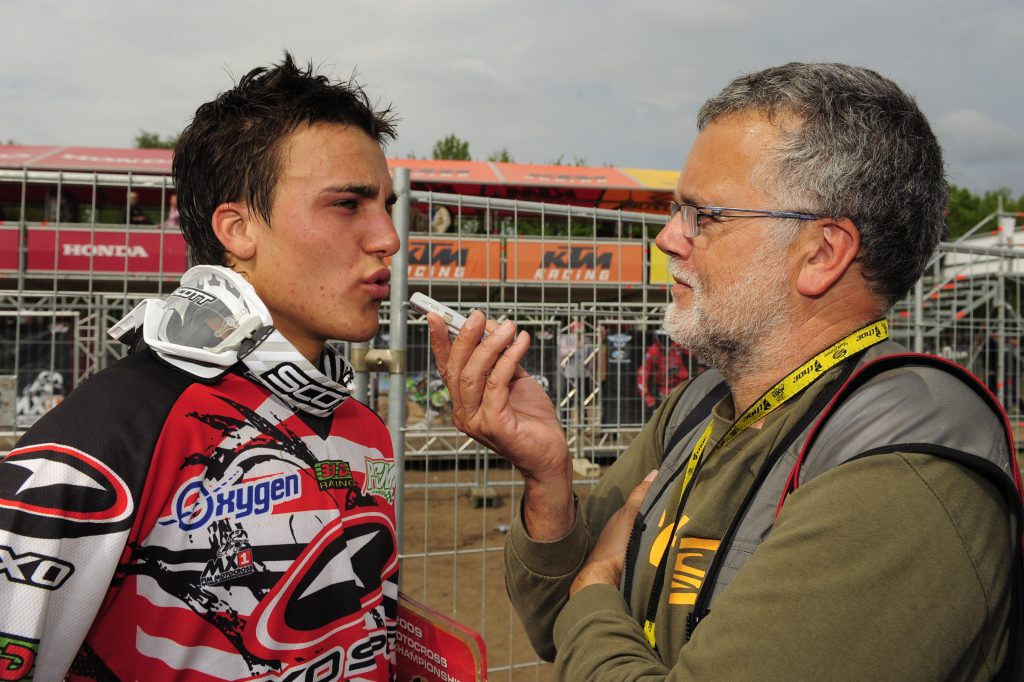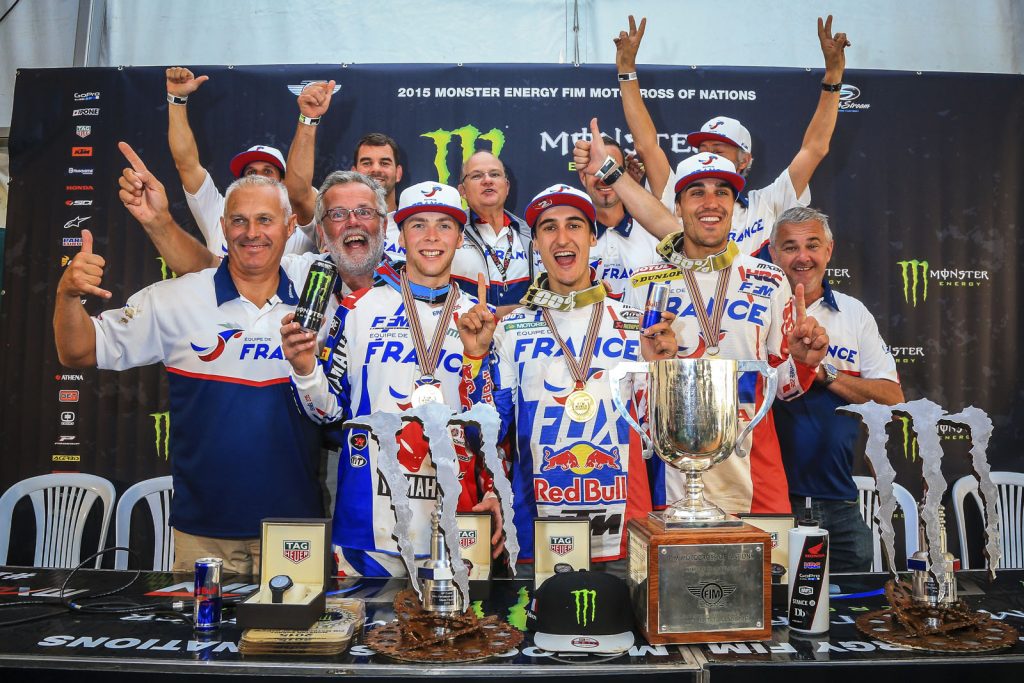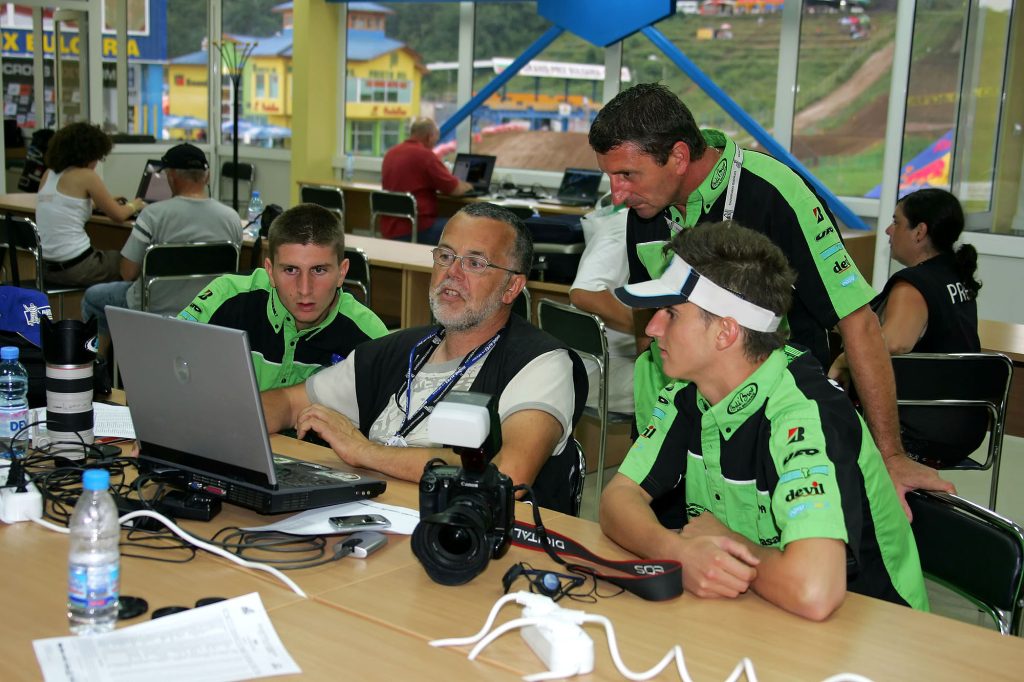Pascal Haudiquert’s arguably the world’s premier motocross journalist. Haudiquert, who is from France, first started to cover the FIM Motocross World Championship in 1978 and has done it all in the forty-five years that he has spent at the very top of the sport. So influential is Haudiquert that the promoters of the Grands Prix held a rather special event to celebrate his 500th event as a leading member of the media, something that no one else has ever managed in the sport!

Not only that, but he has also led IMPA (International Motocross Press Association) since the 1980s… The association includes the most professional journalists and photographers in the world. Only those who pass Haudiquert’s strict criteria are eligible for inclusion, which again speaks for his history in the sport and how entrenched he is in motocross at the highest level and media. There is so much to learn when it comes to the French journalist and we try to shed light on his life in this exclusive interview.
Live Motocross: How did you get into the motocross industry and what year did you start working? What was your first job?
Pascal Haudiquert: I attended my first motocross Grand Prix (the 500cc French Grand Prix) in 1974 in my native village, Gaillefontaine, and I started to do some photos from that day on. When I was at a race, I tried to sell them to the riders. It was not like it is now, just a few black and white pics, and that is how I became friends with one of the best French riders of this period, Jean Jacques Bruno, as his father asked me to make pictures for them. One of my friend at school was the French champion in 1977 (senior class) and in 1978 he was racing for the TGM French importer (Italian bike, their top rider was Michele Rinaldi) and started to race the Grand Prix. I travelled with him and his mechanic in a small van to attend the Grand Prix of Austria in 1978 at Launsdorf – it was the first round of the 125cc World Championship. There was no French reporter, so when we came back I sent some pics to a monthly magazine called ‘Les Cahiers du Cross’ who published them and asked me to cover more races.
Live Motocross: You have worked for so many brands in the sport. What are some of your favourite projects that you have worked on? Which relationships have meant the most to you?
Pascal Haudiquert: I have worked with so many brands, teams and clubs. I would name a few…
- The 1988 Motocross of Nations in France. I had a close relationship with Jean Pierre Mougin, who was the president of the club and of French motocross. It was the first time since a while that the MXoN was back in France. I took two weeks of holidays to work closely with the club and that was a huge success.
- I had the opportunity to work as press officer for Giuseppe Luongo when he created the Masters of Motocross. It was a good experience, and when Giuseppe became promoter of the Grands Prix then he called me to be his press officer for the 250 Grands Prix. I did that job from 1997 until 2006 (for Action Group, then Dorna and then Youthstream). Those are good memories. I enjoyed doing the interviews just after each moto for the live television so much.
- Working for the French team at the MXoN every year since 2007 is for sure one of my best memories. That is unique, to be inside the team for such an event and especially since they won five in a row.
- I can add also that it has been nice to be press officer of almost all the French Grands Prix since 1984 (that was the 250cc Grand Prix in Saint Jean d’Angely).
- Another good memory was in 1989 when Jacky Vimond built his private team and asked me to do the media service for him (at this period we just had a fax machines). Since this period we have kept a great relationship!

Live Motocross: You have worked closely with so many of the French riders and teams, helping them achieve their goals in this big sport. Who have you had the greatest relationship with?
If I have to give some names then I would say Yves Demaria, Sébastien Tortelli, Mickael Maschio, Livia Lancelot and Mickael Pichon. In fact, I had good relationship with almost all the French champions. The fact that I have known them since they are thirteen or fourteen racing the young classes means that they do not just see me when they have glory. I did so many interviews with all of them that we have a good relationship.
Live Motocross: You started IMPA in the 1990s, proving your expertise and influence in motocross. What was the reason for starting the association and how positive has the impact been?
Pascal Haudiquert: In the 1980s when we went to Grands Prix, it was sometimes impossible to get a simple results sheet, and at some Grands Prix then you did not even have a media location! So with some friends, such as Peter Van Der Sanden, we decided to create IMPA to be a kind of force to influence the sport and actions behind the scenes. We had a good relationship with the former FIM Press officer, Marc Pétrier, and he helped us to be recognized. When Giuseppe hired me as press officer, he gave me all what I requested for the professional and elite media members. One of his goals was to promote the sport. Now IMPA is still there, after more than thirty years, and the last item that we actioned was for elite members be allowed to cross the track during the races. We keep eyes open all of the time. For example, when [Clement] Desalle hit photographers at Maggiora a few years ago then the Fédération Internationale de Motocyclisme wanted to park us in just a few zones. Thankfully, with the good relationship that IMPA has with the FIM Motocross World Championship promoters then we could discuss to keep the possibility of our exclusive members to work in the very best conditions.
Live Motocross: You have travelled to so many countries and venues as a member of the media. Which places have been your favourites?
Pascal Haudiquert: Argentina, for sure. I love this Grand Prix and country especially Patagonia where you find amazing landscapes, good wines, very good food and enthusiasts. I have great memories from South Africa, I brought twenty people (including riders) to the Kruger Park after the last Grand Prix in Nelspruit and everyone still talks about this. I would love to go back to Japan, even if in this country you cannot move by yourself as you do not understand the signs on the roads. In Europe, Italy is for sure my favourite one then it is Portugal and the Nordic countries. Concerning the venues, I do not really like to go to tracks that did not change anything in ten or fifteen years. It is boring for the riders, but also for the photographers!
Live Motocross: What do you think of the way that the media has changed over the years? You have seen so many different eras!
Pascal Haudiquert: I will talk as an old guy but when you remember how difficult it was to work in the 80s with no cellular, no fax, no phone… You had to find a phone cabin on your way to send a report. You did not have as much stress as you have now, as you had nothing to do between the races (there was no social media and no digital camera) apart from talking with the riders and mechanics. You would go back home as soon as possible to give your films to a laboratory. I would say that everything has changed with the triple Grands Prix. Now you have no time to talk with anyone or to work between the practice sessions/races. I would add that digital cameras changed our life. It is easier to work, but now we make too many pictures. When you had to buy films then you would use it carefully and not take 1000 pics or more each week. Social media makes our life more difficult, as you need to post all through the day…

Live Motocross: What advice would you give to someone who is hoping to be the next Pascal Haudiquert?
Pascal Haudiquert: First of all, respect your colleagues and work seriously to make this job. This is important for inclusion in IMPA. I think that it’s really difficult to make this job a full-time job, especially if you are just a photographer. I am lucky to be a writer also, so I can offer a full service (pictures and reports) to my clients. Now all the manufacturers provide HR pics for free to the magazines, so it is not easy to find a place and especially now as there is less printed magazines.
Live Motocross: If you could see one track return to the MXGP calendar, which one would you choose and why?
Pascal Haudiquert: For sure, Payerne in Switzerland. Such a nice natural track!
Live Motocross: You have overseen a golden era in French motocross with riders claiming championship titles all over the world in recent years. Not to mention the MXoN success! What do you think was the catalyst for this success? What does the FFM do that creates so many successful French MX riders?
Pascal Haudiquert: The first Grand Prix winner was Daniel Pean in 1977. The first rider signed by a Japanese factory was Jean Jacques Bruno in 1980 (Suzuki), then our first world champion was Jacky Vimond in 1986. These three riders were an example for the young riders, they proved that winning GPs and titles were possible for a French guy. Then in 1991 the Federation created the “French Hopeful Team” and hired Jacky Vimond to be the coach. Since then the French Federation always invest in young riders; they have a coach for all classes (85cc, 125cc and 250F) who organise training camps and attend all the European rounds of the championship to prepare our best young riders to become professional riders. Concerning the MXoN, the Federation invests a lot to create a real team spirit (and that is not only words) and provide the best facilities (trainer, doctor, physio and much more) to the riders so they can focus on racing and just racing.
Photos: Provided by Pascal.


